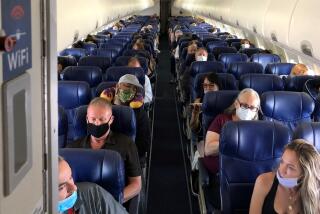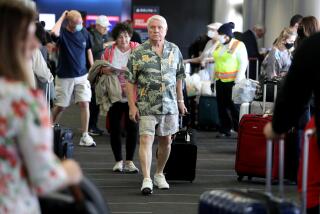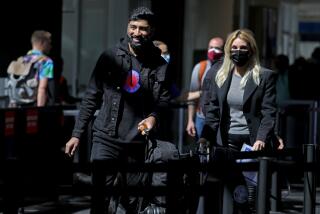Fliers Find Substitutes as Smoking Ban Takes Effect
Raybert Radomes, arriving at Los Angeles International Airport on Sunday after a business trip to St. Louis, said he had resorted to a traditional on-board coping mechanism in response to new federal regulations banning smoking on most domestic flights.
“I just slept,” said Radomes, a medical biller who ordinarily smokes two packs a day. To make sleeping easier, he said, he had “stoked” up on three cigarettes immediately before boarding his flight. “I’m like a chimney,” said Radomes, who lives in Los Angeles.
His response was typical of smokers all over the country facing the prospect of long flights without the benefit of nicotine.
The law that went into effect Sunday bans smoking on all flights within the continental United States and all domestic flights of six hours or less. The law, passed by Congress last year, replaces a 1988 prohibition against smoking on flights of two hours or less. Almost all of the 18,000 domestic flights airlines make each day are affected, with the only exceptions being some flights to Hawaii or Alaska.
Airline officials in most major cities, including Los Angeles, reported almost no complaints about the new regulations Sunday. “Most people are just ecstatic when you tell them there’s no smoking,” said Miriam Howell, a Delta Air Lines agent in New York.
Smokers, however, were a good deal less than pleased.
Dave Noeth, a passenger at LaGuardia Airport in New York City, told the Associated Press that he would abide by the rules, but “if the plane starts to go down, I’m lighting up.”
And a smoker at Pan American Airways’ terminal at Kennedy International Airport across town said she planned to “eat a lot, chew gum and suck Life Savers” to cope during a planned flight to San Diego.
Apparently in anticipation of such responses, the Chicago Lung Assn. distributed free “Smokers Survival Kits” at O’Hare International Airport, complete with sugar-free gum, mints and mouthwash. Among the association’s recommendations were that smokers keep busy while airborne with reading, knitting or crossword puzzles, as well as minimize the urge to smoke by keeping blood sugar constant. To accomplish that, the association recommended passengers avoid snacking on sugar-laden foods, as well as refrain from drinking caffeinated coffee and soft drinks.
At LAX, some passengers seemed to be arriving at the same conclusions on their own. “They’re looking for substitutes,” said Cory Santos, a sales clerk in one of the airport’s gift shops where, she said, cigarette sales were down about 25% and sales of chewable candies, mints and gums were up by about the same percentage.
Everyone seemed to be coping in his or her own way.
Rick Richards, a guitarist in a rock band en route to Atlanta after taping a video in Los Angeles, was traipsing through the airport, frantically puffing on a cigarette before boarding his plane. “I’ve got to get my fix,” he said, adding that he was “disappointed” by the ban.
A woman smoking in an airport restaurant jokingly wondered how, with smoking no longer allowed in airplanes, airline officials would be able to detect cracks in the fuselage. “I always thought they found them by watching where the smoke leaked out,” she quipped.
And at Orange County’s John Wayne International Airport, Daniel Reymer, who had just flown in from Mammoth, Calif., was still venting his frustrations.
“So now you can’t go anywhere without a smoking ban,” he complained. “That’s like saying you can’t go to the bathroom.”
Times staff writer Ted Johnson in Orange County contributed to this story.
More to Read
Sign up for Essential California
The most important California stories and recommendations in your inbox every morning.
You may occasionally receive promotional content from the Los Angeles Times.










